No, but do I need to?Can you measure the properties of a Purify chassis with a €50,- microphone? No. That's what I wrote.
No for a couple of reasons
1 - they are being measured by so many 3rd parties. So their behaviour is known.
2 - depending on the model, they perform best in class (not all of them do), so why would bother verifying that once again?
3 - it once again totally assumes that distortion is the major factor in loudspeaker design. Which it's not.
So, seen from all practical reasons, yes you can measure a Purifi drivers perfectly well with 50 dollar microphone (given it's calibrated, but that was already being mentioned).
Totally agree with this, I also have nothing but compliments about sharing and showing this data! 👍👍We are a community of collaborators here.
Soon you may see more comparisons from others, including all manner of microphones…
Thanks again @IamJF for publicly showing his data.
I already said that right from the beginning.
But that's a totally different thing.
If I understand this correctly, the conclusion is that 1.75% H2 is contributed by the air alone, for a 12" driver in a 40L box at 10mm excursion?
Is this why he puts a small pin hole in his sealed woofer boxes?
Is this why he puts a small pin hole in his sealed woofer boxes?
On the one hand you need to provide a way for the air pressure to balance as it changes but it needs to be long enough or it will squeek like crazy. The premium microphones also have the tiny port limiting their low frequency response usually to 1 Hz or so.Is this why he puts a small pin hole in his sealed woofer boxes?
Yes. You can use his equations to calculate H2 for any other Sd/Xmax/V0 combination. Anyway, I guess this demonstrates that the air contributes quite a bit of non-linearity already, and many measurement microphones have substantially lower distortion. Don't get too excited with looking for super-low distortion microphones.If I understand this correctly, the conclusion is that 1.75% H2 is contributed by the air alone, for a 12" driver in a 40L box at 10mm excursion?
No. A small pin hole will allow slow equilibration of the air pressure inside the box with the outside, but it will not pass substantial pressure fluctuations at audio frequencies.Is this why he puts a small pin hole in his sealed woofer boxes?
An old rule of thumb I've learned is to make the box volume no less than 100x the displacement volume which seems to be in line with the Linkwitz formula.If I understand this correctly, the conclusion is that 1.75% H2 is contributed by the air alone, for a 12" driver in a 40L box at 10mm excursion?
This of course depends on how much inner (or outer) feedback is applied to the driver. With full motional feedback there is no additional distortion from the box air volume (for a closed box).
It's 100% not needed!Is this why he puts a small pin hole in his sealed woofer boxes?
The pressure chamber I did these measurements with needs to be able to perform "DC" pressure (changing and keeping pressure even for a few seconds) - it took me a while to get it THAT sealed. It's an 8" Chassis with thick and very stable paper membrane and rubber surround - the membrane needs a thick coat, otherwise air leaks through. Directly through a thick paper membrane ... that was the last leakage path I thought about.
When you have a seald cabinet and push the woofer mebrane inside there is air resistance - you feel the air spring. Keep it inside for a while so it settles. Now release.
When the cone is NOT comming back and sticking at it's wrong 0-position - THEN you would need a vent hole. But that does not happen.
If you want to get sure - just don't seal your Speakon terminals. Tight enough to not make sounds, gives enough leakage for pressure changes.
You DO use Speakon Terminals, right? 🤓
Back to topic - these ventholes are actually important for microphones. Cheaper ones have them bigger and with more tolerances, therefore you already get errors at 20Hz.
But to be honest, as soon as your speaker get's into a room ...
If I understand this correctly, the conclusion is that 1.75% H2 is contributed by the air alone, for a 12" driver in a 40L box at 10mm excursion?
Is this why he puts a small pin hole in his sealed woofer boxes?
No this not why there is a tiny hole in a "sealed" woofer enclosure. The tiny hole is there to equalize pressures that happen much more slowly and less vigorously than a 20Vrms signal applier to the driver voice coil. Even a 4 inch Bass reflex port is not large enough to do that.
Just for grins look at the data sheet for a GRAS microphone, microphones are rated in Pascals per mV output. Microphones are pressure sensors. Pascals are units of pressure, like Pounds per Square Inch.
The same way a 12 inch woofer with 100 Watts input (Watts := Volts times Amps) generates pressure in a sealed woofer enclosure that same pressure change will generate Voltage output from a microphone in the same enclosure. At that instant in time the microphone voltage output represents the pressure in the speaker enclosure.
Thank you @DualTriode and @IamJF
But to be clear, a 12" woofer in a 40L box at 10mm cone excursion out (or in) has 1.75% H2?
eg. RSS315HF-4, driven with 27V in 40L box hits 10mm at 30Hz (102dB 2pi)

But to be clear, a 12" woofer in a 40L box at 10mm cone excursion out (or in) has 1.75% H2?
eg. RSS315HF-4, driven with 27V in 40L box hits 10mm at 30Hz (102dB 2pi)
In what kind of extreme conditions is someone living to have such extreme pressure fluctuations?No this not why there is a tiny hole in a "sealed" woofer enclosure. The tiny hole is there to equalize pressures that happen much more slowly and less vigorously than a 20Vrms signal applier to the driver voice coil.
Yes. Well, actually, no, not the woofer. The air distorts with H2 = 1.75%. Any distortion by the woofer itself is on top of that.But to be clear, a 12" woofer in a 40L box at 10mm cone excursion out (or in) has 1.75% H2?
With 10mm excursion, you don’t have to worry about 1,75% distortion of the enclosed air.
Agreed with @markbakk. A good 12" woofer in a 40-50L sealed box will have about 12-13% H2 around 30Hz, when excursion is +/- 10mm. So I didn't think 1.75% significant. Perhaps I took it out of context. Why did SL do that calculation? I don't think it would be a case for going for dipole bass. You need even MORE excursion (and thus distortion) to reach the same SPL...
Last edited:
Now I keep on wondering how low the Behringer would go below 95dB ...As there was a lot of discussion about microphone distortion here recently and I'm actually working on a pressure chamber which can produce >160dBSpl ... I spent an afternoon to do some microphone measurements.
Setup
A pressure chamber is a device with a speaker membrane with a very small and 100% sealed front chamber. This pushes the resonance frequency of the 8" speaker to about 350Hz in my case - the volume is that small. But you can produce huge pressure changes now!
Measurements as always done with proper gear (APx515, Class1 Calibrator, Benchmark AHB2 Amp etc).
Measurement frequency is 250Hz (to be sure we are in 100% pressure chamber behaviour and it's the recommended calibration frequency by B&K and GRAS), stepped level sweep, 31 steps.
Check of the chamber - how much THD produces the speaker.
Such a pressure chamber produces stupendous SPL at very little membrane movement - so there is very little THD from the speaker. To check my limits I did the first 2 measurements with a GRAS 1/4" 40BD capsule with 2 different "preamps" (actually just impedance converters, they are just called preamps but there is no amplification).
That's the result.
View attachment 1295189
There is a LOT of noise and some strange stuff between 115 and 135dBSpl going on with these 1/4" capsules - legit THD measurements are only starting from 140dBSpl and up. So we produce 150dBSpl with <1%THD and 160dBSpl <3%THD. We don't know if that's the speaker or the refmic! (I have an idea ...)
But we are sure about staying under 1% <150dBSpl and 3% <160dBSpl
So how are our microphones performing.
View attachment 1295191
Here you see the linearity graph. 160dBSpl is easy for our 1/4" capsule. Not so for the other microphones ...
M50 gets to 145dBSpl - spec is 140dBSpl
M215 around 140dBSpl depending on capsule sensitivity -> preamp distortion. Spec is 135dBSpl.
I didn't bother to look after the Behringer Mic spec as it's just here as deterrent example - but >130dBSpl is actually not bad!
But what about THD?!
Here it is - the truth about reference microphone THD:
View attachment 1295193
As expected ... don't use cheap measurement microphones for delicate measurements. They can't do them. The Behringer is out.
Interesting is that the Earthworks has higher THD as the M215! Noise area is up to about 105dBSpl (there is a lot of noise in the pressure chamber cause of it's sensitivity!!!) but then we get valid measurements. At the specified 140dBSpl max it has already 2% THD - that's A LOT! Studio microphones are normally specified with 0,5% THD, somtimes with 1% when the manufacturer wants to push it a little.
M215 - 135dBSpl is where the preamp starts distorting - that's not a limit of the capsule! Actually - it is when you take the 0,5% THD rule ...
BUT - one of the M215 amplifiers produces more noise as it should. Noise should be less as the M50 (dark green) but number 1 has more noise (light green). Will have to investigate, maybe just dirt in the high impedance area (these mics don't get pampered).
You can calculate your THD from this graph for lower SPL. -20dB -> 1/10th of THD. Even the Behringer follows that rule, it's how a condenser capsule SHOULD behave in theory. And they do!
So what about higher order harmonics?
tbc.
As a rule of thumb, distortion with most subwoofers at full xmax is even at 20% distortion actually.Agreed with @markbakk. A good 12" woofer in a 40-50L sealed box will have about 12-13% H2 around 30Hz, when excursion is +/- 10mm. So I didn't think 1.75% significant. Perhaps I took it out of context. Why did SL do that calculation? I don't think it would be a case for going for dipole bass. You need even MORE excursion (and thus distortion) to reach the same SPL...
= BL dropping at 70% or Compliance dropping to 50%
There are definitely exceptions in doing a lot better or doing a whole lot worse.
Not just that 1.75% is not really that significance, bust just simulate what it does to the system response with a BL that is only 70% of its original value.
I’m with you @b_force
IIRC, that’s Klippel’s definition for x max of subwoofers, I believe, based on BL/Kms/Le dropping below predefined limits (82%/75% etc)
Some (sub)woofers do better or worse than the (20)10% distortion, of course. My comment of 12-13% is from empirical data. eg. my own, or SVS SB12-NSD
Which brings me to comment, I'm a bit disappointed by Voice Coil's continued use of a microphone that get dangerously close to distorting itself.
There are many measurements where the microphone is observes levels approaching 120dB:
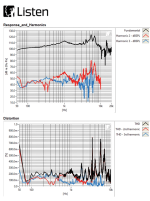
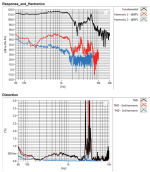
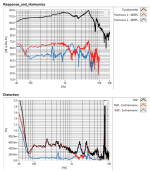
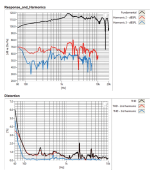
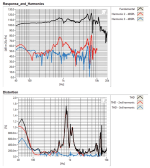
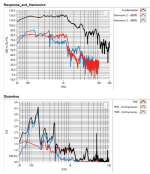
Reference:
https://audioxpress.com/tags/Test-Bench
As @IamJF has shown, the difference between a microphone's own THD of 0.5% and 1% is just 6dB.
But the microphone regularly used in Test Bench is Listen Inc's SCM3, a nice mic but whose specifications show a maximum of 123dB for 1% THD
If one is going to make a measurement, attempts should be made to avoid testing the test equipment
I know Vance is busy, and so probably has an automated test rig. If someone could reach out to him, perhaps an industry professional, or a microphone manufacturer, to let him know that a microphone with a 155+ dB capability would be better...
Otherwise, Voice Coil is showing distortion measurements affected microphone distortion.
IIRC, that’s Klippel’s definition for x max of subwoofers, I believe, based on BL/Kms/Le dropping below predefined limits (82%/75% etc)
Some (sub)woofers do better or worse than the (20)10% distortion, of course. My comment of 12-13% is from empirical data. eg. my own, or SVS SB12-NSD
Which brings me to comment, I'm a bit disappointed by Voice Coil's continued use of a microphone that get dangerously close to distorting itself.
There are many measurements where the microphone is observes levels approaching 120dB:






Reference:
https://audioxpress.com/tags/Test-Bench
As @IamJF has shown, the difference between a microphone's own THD of 0.5% and 1% is just 6dB.
But the microphone regularly used in Test Bench is Listen Inc's SCM3, a nice mic but whose specifications show a maximum of 123dB for 1% THD
If one is going to make a measurement, attempts should be made to avoid testing the test equipment
I know Vance is busy, and so probably has an automated test rig. If someone could reach out to him, perhaps an industry professional, or a microphone manufacturer, to let him know that a microphone with a 155+ dB capability would be better...
Otherwise, Voice Coil is showing distortion measurements affected microphone distortion.
Last edited:
If that's the only thing you're disappointment about? lol 😀 😀I'm a bit disappointed by Voice Coil's continued use of a microphone that get dangerously close to distorting itself.
I can make a whole list.
But one of the biggest is only using one single sound pressure level to do these tests.
Which gives us absolute no idea at all how a certain distortion problem develops (and where it's coming from).
The second one is using absolutely totally silly and unusable graph ranges.
Good gull-range mid-woofers that only show distortion from 100Hz and up, subwoofers that only show 50Hz and up etc.
If we want to compare the low end we need to make sure the system response is identical between drivers.
As far as I know, absolutely no-one doing 3rd party measurements has been doing such thing in the last 30 years.
Since we use subwoofers so close to the drivers Fs, I find Klippel LSI saying a lot more than just distortion measurements.
As I already now said multiple times before we DON'T need to measure at insane sound pressure levels, we just have to measure on a good level where we can compare drivers on a relative way.
Anything else can be extrapolated from there, especially in combination with those Klippel LSI measurements.
So the question again, why would you want to measure such insane numbers if there is not a single practical reason for it?
Hello All,In what kind of extreme conditions is someone living to have such extreme pressure fluctuations?
Assumptions Assumptions.
I believe focusing on it is a cognitive or affective thing that makes it an issue.
https://www.ncbi.nlm.nih.gov/pmc/articles/PMC6026651/#:~:text=Cognitive perspective-taking refers to,about others' thoughts and beliefs.&text=Affective perspective-taking is the,about others' emotions and feelings.
Assumptions will turn around and and bite you on the Bass.
Such extreme conditions do not likely exist. Someone some time likely thought thought that the tiny hole was a good idea. It being there does not bother me too much.
I often drill a 1/4 inch+ hole to push a 1/4 inch microphone into the enclosure. Sometimes I forget that the hole is there and never notice that it is.
Thanks DT
- Home
- Loudspeakers
- Multi-Way
- Distortion in Measurement Microphones - actual measurements